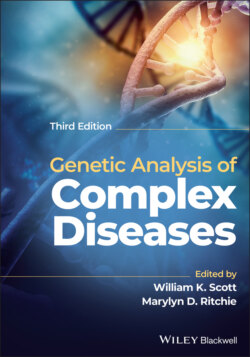Читать книгу Genetic Analysis of Complex Disease - Группа авторов - Страница 68
Healthy or Unaffected Controls
ОглавлениеFor some analyses, it is necessary to have control samples to use for comparison with the patient samples. These control samples may include spouses and siblings of affected individuals, classmates, other members of the community, or even untransmitted genetic alleles. Regardless of the relationship of the control sample to the patient sample, one must ensure that the controls are ascertained from the same study population as the patients. Furthermore, the controls can be matched to the patients for confounding factors (any factor that might influence the association between the disease and genotype), such as age, sex, ethnicity, and geographic location. There are two approaches for matching controls to the cases. First, one can select controls such that the overall distribution of cases and controls is comparable with respect to the frequency of the confounders (e.g. for a study of autism spectrum disorders, both cases and controls have a sex ratio of 3 : 1 males to females). This is referred to as frequency or category matching. Alternatively, one or more control individuals may be selected to match each case based on the confounding characteristics (e.g. the case and the control are both African‐American females, eight years of age, and reside in Durham County, North Carolina). This approach is called individual matching. An alternative to matching is to consider these potential confounders in statistical analyses, although this may be a less statistically powerful approach. With the increasing availability of publicly accessible data sets, it has become feasible to utilizing existing controls, so long as there is careful consideration of the potential confounding factors. A landmark study by The Wellcome Trust Case Control Consortium (2007) was the first to robustly demonstrate the use of a common set of controls for identifying genetic factors associated with multiple conditions. Subsequently, it has become commonplace to utilize common, publicly available control samples.
It is important to keep in mind that improper selection of controls can lead to incorrect conclusions. For example, if cases and controls are not appropriately matched on ethnicity and the frequency of alleles for the genetic marker differs by ethnicity, an association study can be doomed. One may falsely conclude an association between a genetic marker and the condition if the “at‐risk” marker allele is more prevalent in the predominant ethnicity of the cases versus the controls (e.g. Knowler et al. 1988). Examples of population stratification and approaches for its detection and control of its effects are described more in Chapter 8.
